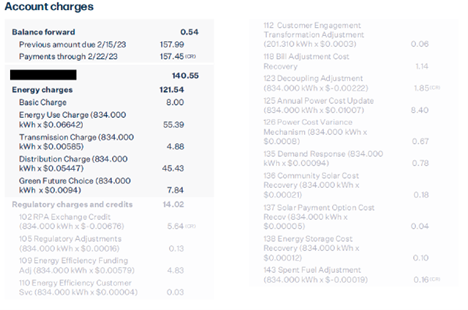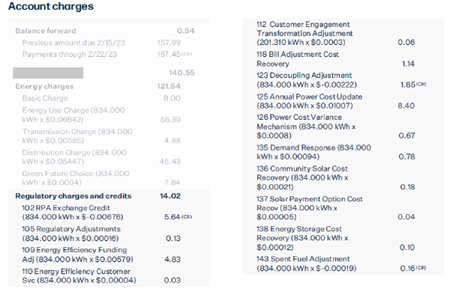Are Oregon Utility Customers Being Nickeled and Dimed?
Posted on March 28, 2023 by Charlotte Shuff
Tags, Energy, General Interest

Increasingly, Oregon utilities are asking for more money from customers for one-off or specific programs. While this may sound inconsequential, it is a larger trend that concerns CUB and other consumer advocates. These single-issue surcharges help utilities avoid oversight and could lead to customers overpaying for utility service.
To give a view of how common this is, Portland General Electric alone currently lists 32 such surcharges (see “Adjustment Schedules” in the full list). While some of these charges are required by various laws, many are not.
What’s the Problem with Single-Issue Surcharges?
Single-issue surcharges add potentially unnecessary costs to customers even though those costs may already be covered by their current utility bills.
Holistic vs. Single-Issue Utility Regulation
Holistic Utility Regulation: Under traditional rate making in a general rate case, regulators consider utilities’ investments, the overall cost of providing service, profits, and more.
Utilities must show the amount necessary to charge customers to provide reliable service and receive a reasonable profit. This is the model that creates the majority of costs on customers’ bills (often referred to as Energy Charges in bills).
For a long time, the holistic model was the standard for utility regulation. Over the past couple of decades, utilities have increasingly asked for surcharges outside of this process. These surcharges result in the single-issue regulation process outlined below.

CUB Outreach Manager’s PGE bill in January 2023 included $121.54 in costs unrelated to single-issue surcharges (almost 90% of their total bill).
Single Issue Regulation: In the case of single-issue rate-making, regulators typically only look at the utility costs and surcharge requests related to a single issue. One recent example of a single-issue surcharge is the Wildfire Mitigation cases this spring. PGE and Pacific Power both asked to add a surcharge to cover costs related to wildfire prevention. Other examples of single-issue requests include surcharges to cover costs associated with the 2021 ice storm and pilot programs for electric vehicle investments.
In most instances, other charges to customers outside of these single issues are not considered. Regulators approve or deny these surcharges based on a set of criteria related only to the single issue the surcharge is meant to cover. Regulators often can’t look at the overall cost of providing service, profits, and other factors that are included in the holistic model. This limited scope can lead to unnecessarily high bills and can be bad for customers.
Single-issue cases, like the wildfire mitigation example, are allowed by Oregon law. In the case of wildfire mitigation, the utilities were actually required by law to add these costs. However, a single-issue surcharge was not required. Generally speaking, surcharges are typically reserved for limited circumstances.
CUB is concerned that the utilities are bringing forward too many single-issue requests. This could result in customers being overcharged for their utility services as utilities avoid holistic regulation.

CUB Outreach Manager’s PGE bill in January 2023 included $14.02 from 13 surcharges from single-issue cases (more than 10% of their total bill).
Single-Issue Surcharges Raise Bills in a Vacuum
In the holistic utility regulation model, utilities’ costs are evaluated all at once. CUB, and many other advocates, believe that the rate charged by utilities should be decided using this method. Through traditional, holistic regulation, utility bills more accurately reflect the cost of service. Only in unusual circumstances should surcharges be used to collect utility costs.
Going outside of the more holistic general rate case model, utilities can add a lot of small charges to customers with less oversight. Regulators can’t look at the overall amount customers are paying for utilities. Nor can they look at the overall cost of the utility service.
As single-issue surcharges pile up, customers could be paying more than is necessary to cover the cost of their utility service.
Consumer Protections Don’t Help Utilities’ Bottom Line (But Single-Issue Surcharges Do)
Utilities Won’t Ask for Less Money, Only More
Utilities will not file these one-off requests for costs that are declining. But we know that costs can go up and down. By focusing on single-issue items and ignoring overall costs, regulators lose the ability to say whether customers are paying just and reasonable bills.
With limited insight into utility operations, it is difficult for CUB and consumer advocates to file single-issue cases when costs do decline. The utilities are at a tremendous advantage and can file these cases whenever their costs increase.
When the Oregon Public Utility Commission is engaged in holistic regulation, it includes costs that are going up and costs that are going down. With single-issue requests, utilities can avoid filing single-issue cases when their costs have decreased. As surcharges pile up, customers could be stuck paying extra for their utility service.
Surcharges Avoid Oversight Mechanisms
Utilities benefit by avoiding a full investigation into their costs, earnings, and revenue. Opening a holistic general rate case means that utilities have to face more oversight from state regulators (and watchdogs like CUB).
One example of this is Pacific Power. For years, the utility relied primarily on surcharge cases to raise customer bills. In 2022, the utility requested a bill increase through the more holistic general rate case process. After looking at the overall cost of service, regulators concluded that the company’s profit margins were too high and customers were being overcharged. Holistic regulation from the general rate case actually lowered Pacific Power’s profit margins.
Surcharges Help Utilities Avoid Normal Business Risk
Utilities know that surcharges mean that they have to absorb fewer costs. Absorbing costs is a part of any business.
When you go to the grocery store and buy an onion, you know what that onion will cost. The cost is posted at the store and is the same at the register. Some days, the onion might cost the store a little more than what you paid. Some days, the onion might cost the store considerably less than what you paid. Here, the store is absorbing the cost of ever-fluctuating prices of onions.
Utilities don’t want to absorb fluctuating costs, though. The grocery store doesn’t come back months later and ask you for a surcharge when they didn’t earn as much as they wanted on your onion. But that’s what utilities are asking of Oregon households with single-issue surcharges.
CUB is Pushing for Stronger Customer Protections
CUB is here for the interests of Oregon households, not corporate profits. We will continue to advocate for lower utility bills. We want more oversight on utilities, not less. CUB analysts and attorneys will continue to investigate single-issue surcharges. We will push for utility regulation that supports consumer protections.
Stay Up to Date on Oregon Utility Issues
CUB will continue to advocate for people in Oregon on major utility issues. Sign up for the CUB email list for the latest updates, action alerts, and news on policies that affect the utilities your home relies on.

To keep up with CUB, like us on Facebook and follow us on Twitter!




03/29/24 | 0 Comments | Are Oregon Utility Customers Being Nickeled and Dimed?